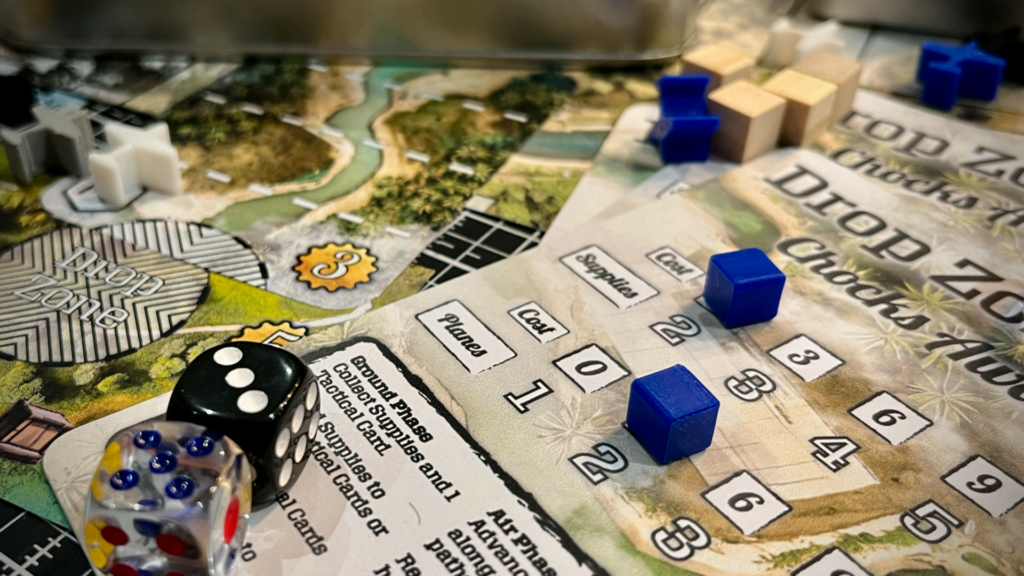This week we’re diving into a fascinating corner of the gaming world that many designers have never encountered: play-by-mail games. Our guest, Michael from Taylored Dice, has been crafting these long-form, socially rich gaming experiences that unfold over months rather than hours. From historical sandboxes set in World War II Europe to science fiction epics featuring alien-orchestrated planetary warfare, these games represent a unique blend of strategic gameplay and human storytelling that harks back to gaming’s earliest roots, yet feels surprisingly relevant in our digital age.
What makes this conversation particularly compelling is how Michael has transformed an ancient format into a modern design practice that tackles some of gaming’s most interesting challenges. How do you create suspense and intrigue when players have days to consider their moves? How do you manage the social dynamics of backstabbing and alliance-building across weeks of gameplay? And perhaps most intriguingly for indie designers, could this labour-intensive format actually represent a viable business model in today’s market?
Enjoy.
Joe: Hiya, welcome to the What If? Blog. It’s great to have you with us this week. Can you start us off by telling us what brings you to the world of board game design?
Michael: Hey Joe, thanks for having me here! I can indeed. I’ve been designing board games for as long as I can remember! I would have started off with paper games in primary school, using building bricks to make boards and filling an endless number of notebooks with rules and character stats.

It wasn’t until sixth form when I realised that some people could make a job of it, so I started trying to get a better understanding of the industry. Last year I stumbled across This Is Not A Game‘s stand at a vegan convention, and saw them selling some of their card games. We got to chatting, and as it turns out they were looking for a designer to work on their next project, and it all grew from there!
Joe: That’s cool – I’ll make sure to check out This Is Not A Game! What sort of games are you working on at the moment?
Michael: Right now I’m working on a few projects, hoping to find a publisher to work with on a bench management game where you play as a government, and you score points through social progression, and a bluffing card game about pairing up foxes with matching environments and food sources. Something I’m always experimenting with though, is play-by-mail and similar games. At the moment I’m designing a historical wargame called Defence of ’39, set in the European theatre.
Joe: Cool! Tell us a bit about the play-by-mail format. I assume it’s been around for a long time. What about it appeals to you as a player and designer?
Michael: Oh yes, it’s been around for ages. In its earliest recorded form, chess was played by mail around the year 800, notably between the Byzantine Emperor Nicephorus and Caliph of Baghdad Harun al-Rashid. But in the modern sense, play-by-mail gained popularity in the 1970s and 80s with games such as Rick Loomis’ Battle Plan and Heroic Fantasy. Play-by-mail games are turn-based and long-term in nature, with games sometimes taking months or even years to complete. Players write their actions for their turn, and post them to a game master of sorts, who reviews the player actions and resolves them, before mailing the outcome of events back to the players.

With the advancement of technology, the genre came to rely increasingly on computers, particularly for resolving increasingly complicated combat interactions, and eventually made the shift to email. Nowadays the genre is fairly niche in the gaming space, but there are still games which began in that era that are still active today. By their nature, these games are highly social, with players being encouraged to use waiting times between rounds to communicate with each other, which gives players space to engage with their roles. Alliance building, trading, posturing and bluffing are some of the many social tools for improving your in-game standing, while simultaneously building human connections. It is this human aspect that draws me into the format the most. I love to see the creative ways that players conceive using game mechanics to outwit each other and how they work together to overcome enemies greater than themselves. From a game master perspective, I find immense enjoyment in seeing everyone’s plans at once, with backstabs and underhanded deals going unnoticed by most players, while I observe the dramatic ironies as they arise. I started making these games for my friends during the COVID lockdown, as a way to maintain some sense of normalcy. I may not have been able to test the games I was making for tabletop, but an online text-based game (and a captive audience) satisfied my love for design, and I just never stopped working on it!
In its earliest recorded form, chess was played by mail around the year 800, notably between the Byzantine Emperor Nicephorus and Caliph of Baghdad Harun al-Rashid.
Joe: I’ve recently been exploring the play-by-mail genre too, in the format of Matrix games, and I have to agree with you—it’s the creative choices that the games and their moderation facilitate in the players that really make them shine! I’m sold on the format, but would like to know, how (and where) do you come up with the ideas for your games? Perhaps you could give an example and tell us its origins?
Michael: Well, as a lover of history, I often take inspiration from tumultuous eras to draw on for game settings. I’ve done WW2 Europe, Roman Empire vs Barbarian tribes, and the Cold War so far. They function as historical sandboxes, with each era offering unique mechanics reflective of the political landscape at that time. But the project I’m perhaps most proud of is Project Globes, which I took in a far more science fiction direction.

With Project Globes, instead of building the game out of the real-world considerations of leading a country, I built the game with the aim of creating suspicion and distrust between players. In Project Globes, a hyper-advanced alien race has used artificial wormholes to put a group of technological-age planets into orbit around a single sun. In their boredom, they make galaxy-wide war games to watch for their amusement, and the winning planet gets to be sent home. This setting frees the players from preconceptions of how their country should be played, and gives them a completely unknown environment to explore. What better place for that than space? The map is cloaked in the fog of war, different players have access to spaceships made by different manufacturers sponsoring the games, and the planets have cryptic coordinates to prevent players from sharing their position easily. This setup promoted far more caution when approaching neighbours of unknown size and strength, the deployment of spies, and the forming of shaky alliances, which led to a lot of chaos, which I’ve explored in a YouTube video on the first test for the game.
Joe: Fantastic! It sounds like a really well thought out and immersive game. What sort of planning goes into creating something like this? And what are the ‘tools of the trade’?
Michael: For planning, I start by putting feelers out into a group to see how many people would be interested in trying it, then I tailor the complexity of the game to better fit the group. I’ll normally release the rules a couple of weeks before round 1 launches, just to give people a chance to look over them in their own time and ask for clarification on anything they don’t understand right away. I aim to have the game calendar planned out for at least 4 rounds in advance, just to give me plenty of time to prepare for upcoming in-game events.

For testing purposes I’m using spreadsheets which store all of the player data, with cells that import the army and navy stats to automate certain combat encounters. For the messaging itself, I’m currently running the games out of Discord, with each player having access to a space to submit actions privately, as well as there being several shared spaces for the rules, updates to the map etc.
Joe: This is a great setup, and probably something I should have been using for the two games I’m running at the moment (currently done via email).
Michael: Thanks! Trial and error (and lots of player shenanigans) has taught me a lot about how to streamline these.
Joe: I’m intrigued by the possibilities these games offer, but I’m finding in my own games they take an incredible amount of time and organisation. And this makes me feel that they would be difficult to offer as a paid-for product. Do you think there’s scope for turning this into a product for sale?
Michael: An excellent question. I’m confident that there’s a market for this. There are already D&D Dungeon Masters for hire, who create experiences for players who don’t have the skills or experience to DM for their own group and what we do isn’t much different. The way I see it, I’m a lower-intensity and longer-term DM, with most of my time on the game being answering queries, and putting player actions into effect on the game board. With a well-organised schedule, the workload isn’t difficult to manage.
Joe: For a digital project like this, where will you sell it? What are the options that you might use?
Michael: I’m currently looking at a few options: Patreon could work well for my more open-ended games, with players subscribing for as long as they want to play the game. For games of a set length though, it might work best to use Shopify to sell packages for a certain number of players for set durations. I’m currently weighing up the benefits of each model.
Joe: Final question for you, how can people find out about your games and the projects you’re working on?
Michael: I post weekly on my Instagram @taylored_dice about board game design tips, as well as the projects that I’m currently working on. I’ll be posting on my YouTube too with videos on past games and future play-by-mail projects that people can get involved with.
What strikes me most about Michael’s approach is how he’s found a way to make the waiting inherent in play-by-mail games into a feature rather than a bug. While most modern game design pushes towards instant gratification and rapid feedback loops, Michael has embraced the slow burn, ceating space for the kind of deep social dynamics and emergent storytelling that can only develop when players have time to really think, scheme, and build relationships.
There’s something beautifully counter-cultural about dedicating months to a single game in our age of quick dopamine hits.
Perhaps most importantly for indie designers, Michael’s work demonstrates that there are still unexplored niches in the gaming world where passionate creators can build sustainable practices. The play-by-mail format might seem antiquated, but it offers something that digital games often struggle with: genuine human connection and the thrill of long-term consequences. Whether you’re inspired to try designing your own correspondence game or simply appreciate the craft involved in managing these complex social experiments, Michael’s journey reminds us that innovation doesn’t always mean moving faster; sometimes it means slowing down and giving players room to surprise you.


